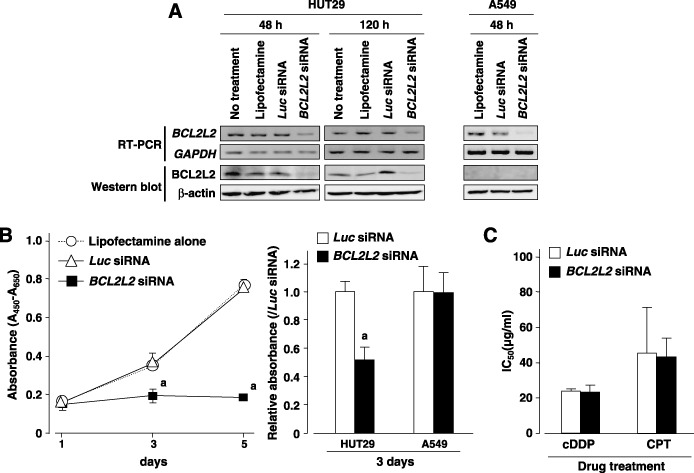Figure 4.

(A) Downregulation of BCL2L2 expression at the mRNA and protein levels was observed after transfection of BCL2L2 small interfering RNA (siRNA) compared with Luc‐siRNA or vehicle (Lipofectamine 2000 reagent) alone in HUT29 cells. The knockdown effect of siRNA was observed even 120 h after transfection in this cell line. In A549 cell line showing low expression of BCL2L2 (Fig. 2), downregulation of BCL2L2 mRNA was also observed 48 h after transfection. However, BCL2L2 protein was not detected by western blotting using 20 µg of protein, even in A549 cells treated with Lipofectamine 2000 alone or the control Luc‐siRNA, indicating that it is difficult to evaluate the effect of BCL2L2‐siRNA treatment on the BCL2L2 protein in this cell line. (B) The effect of downregulation of BCL2L2 expression on cell growth was observed in BCL2L2‐siRNA‐transfected HUT29 cells and control A549 cells. Cell viability was determined by water‐soluble tetrazolium salt (WTS) assay at the indicated times. Knockdown of endogenous BCL2L2 expression by BCL2L2‐siRNA in HUT29 cells significantly decreased cell growth compared with the Luc‐siRNA‐transfected counterpart (left and right). However, no inhibitory effect of BCL2L2‐siRNA treatment on cell growth was observed in A549 cells with low expression of BCL2L2 compared with the Luc‐siRNA treatment (right). Statistical analysis used the Mann–Whitney U‐test: a, P < 0.05 versus Luc‐siRNA treatment. (C) Effect of BCL2L2 knockdown on anticancer reagent‐induced cell death in HUT29 cells. siRNA‐transfected cells were treated with various concentrations of cisplatin (cDDP) or CPT‐11 (CPT) for 48 h. Cell viability was determined by WTS assay, and the inhibition concentration 50% (IC50) was calculated. No difference in viability was observed between BCL2L2‐ and Luc‐siRNA‐transfected cells after treatment with either anticancer reagent.
